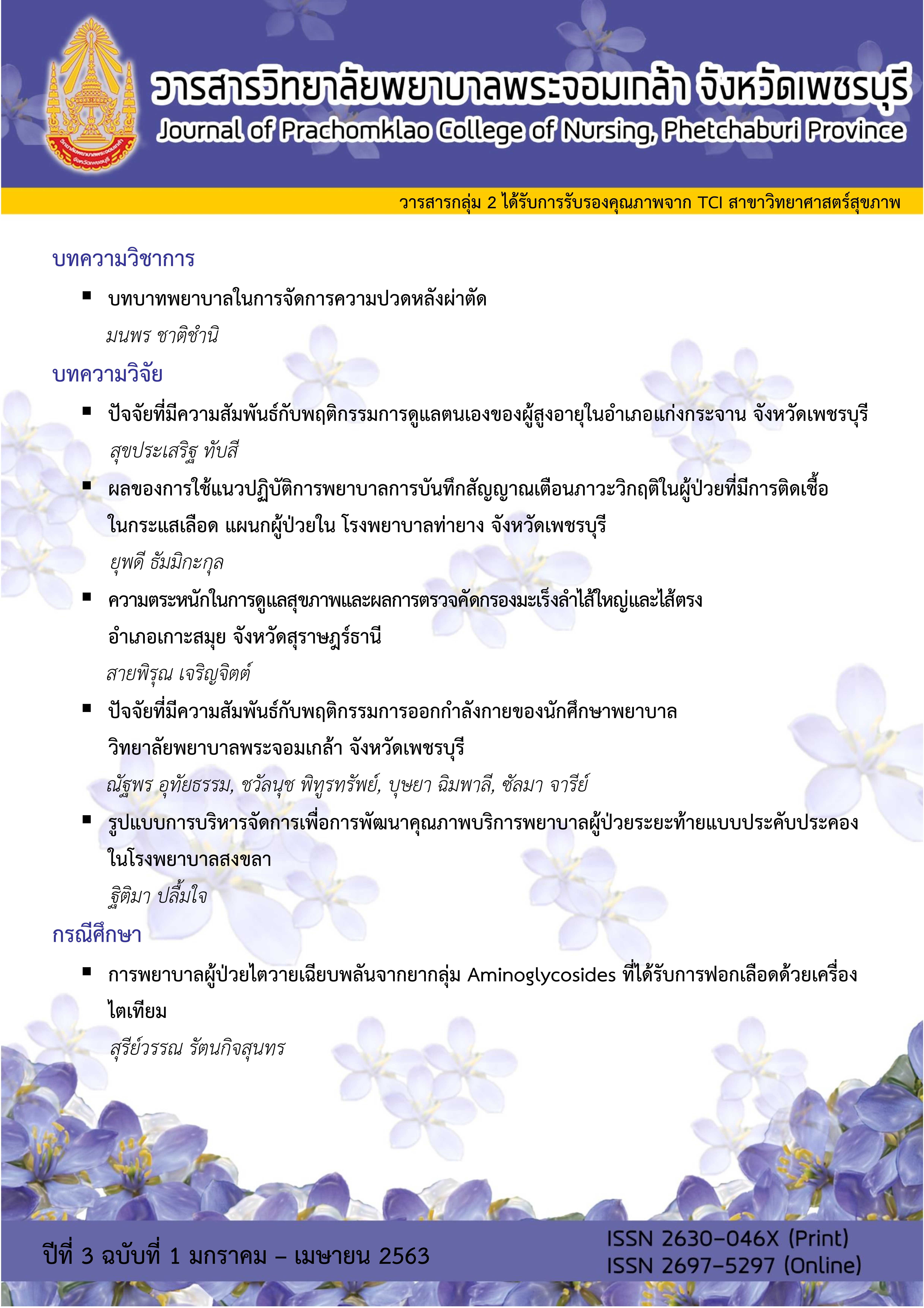บทบาทพยาบาลในการจัดการความปวดหลังผ่าตัด
Main Article Content
บทคัดย่อ
บทความนี้ เป็นการสำรวจบทความวิจัยที่ตีพิมพ์ระหว่างเดือนมกราคม พ.ศ.2544 ถึงมีนาคม พ.ศ.2562 เกี่ยวกับความสำคัญของบทบาทของพยาบาลในการจัดการความปวด เพื่อให้สามารถประยุกต์ใช้ความรู้จากงานวิจัยที่ผ่านมาก่อนทั้งในประเทศและต่างประเทศ และสามารถนำไปใช้ในการดูแลผู้ป่วยหลังการผ่าตัดเพื่อลดอาการปวด ผลการศึกษา พบว่างานวิจัยส่วนใหญ่ที่มีอยู่นั้นเป็นภาพเชิงลบในการประเมินและจัดการความปวดในหอผู้ป่วยศัลยกรรม อย่างไรก็ตาม มีหลักฐานของการพัฒนาเชิงบวกในการปฏิบัติทางคลินิกที่มีศักยภาพในการปรับปรุงจากประสบการณ์ของผู้ป่วยในการจัดการความปวดหลังผ่าตัด
การศึกษาครั้งนี้ มีข้อเสนอแนะเกี่ยวกับบทบาทของพยาบาลในการจัดการความปวด บทบาทของพยาบาลในการจัดการความปวดในด้านการตอบสนองต่อความรู้สึกไม่สบายและความปวดของผู้ป่วย โดยมุ่งเน้นการดูแลผู้ป่วยเป็นศูนย์กลาง แต่พยาบาลมีความสามารถหลากหลายในการประเมิน ติดตาม และดูแลรักษาโดยขึ้นอยู่กับเงื่อนไขของผู้ป่วย เพื่อบรรเทาอาการปวดตามวิธีที่เหมาะสม รวมทั้ง ทักษะการพยาบาลในการจัดการความปวดอาจช่วยให้พัฒนาแนวทางการพยาบาลช่วยผู้ป่วยที่มีความเจ็บปวดในบริบทอื่นๆ ได้
Downloads
Article Details
เนื้อหาและข้อมูลที่เผยแพร่ในวารสารวิทยาลัยพยาบาลพระจอมเกล้า จังหวัดเพชรบุรี ถือเป็นข้อคิดเห็นและความรับผิดชอบของผู้นิพนธ์บทความโดยตรง บทความ เนื้อหา ข้อมูล รูปภาพ ฯลฯ ที่ได้รับการเผยแพร่ในวารสารนี้ ถือเป็นลิขสิทธิ์ของวารสารฯ หากบุคคลหรือหน่วยงานใดต้องการนำทั้งหมดหรือส่วนหนึ่งส่วนใดไปเผยแพร่หรือเพื่อกระทำการใด ๆ จะต้องอ้างอิงวิทยาลัยพยาบาลพระจอมเกล้า จังหวัดเพชรบุรี ทุกครั้ง
เอกสารอ้างอิง
Abrahamsen Grøndahl, V. (2012). Patients’ perceptions of actual care conditions and patient satisfaction with care quality in hospital (Doctoral dissertation). Karlstads University, Sweden.
Al Samaraee, A., Rhind, G., Saleh, U., & Bhattacharya, V. (2010). Factors contributing to poor post-operative abdominal pain management in adult patients: a review. The Surgeon, 8(3), 151-158. doi: 10.1016/j.surge.2009.10.039
Bonica, J. J. (1987). Importance of effective pain control. Acta Anaesthesiologica Scandinavica. 31(Suppl 85), 1-16. doi: 10.1111/j.1399-6576.1987.tb02665.x
Boric, K., Jelicic Kadic, A., Boric, M., Zarandi‐Nowroozi, M., Jakus, D., Cavar, M., ... & Puljak, L. (2019). Outcome domains and pain outcome measures in randomized controlled trials of interventions for postoperative pain in children and adolescents. European Journal of Pain, 23(2), 389-396. doi: 10.1002/ejp.1313
Carr, D. B., & Goudas, L. C. (1999). Acute pain. The Lancet, 353(9169), 2051-2058. doi:10.1016/S0140-6736(99)03313-9
Carr, E. C. (2001). Impact of postoperative pain on patient experience and recovery. Professional Nurse, 17(1), 37-40.
Chatchumni, M., Namvongprom, A., Eriksson, H., & Mazaheri, M. (2016). Thai Nurses’ experiences of post-operative pain assessment and its’ influence on pain management decisions. BMC Nursing, 15(1),12. doi:10.1186/s12912-016-0136-8
Chatchumni, M., Namvongprom, A., Eriksson, H., & Mazaheri, M. (2018). Engagement and availability in shaping nurses’ management of postoperative pain: A qualitative study. Electronic physician, 10(8), 7235-7242. doi: 10.19082/7235
Gottschalk, A., & Smith, D. S. (2001). New concepts in acute pain therapy: Preemptive analgesia. American Family Physician, 63(10), 1979-1985.
Grinstein-Cohen, O., Sarid, O., Attar, D., Pilpel, D., & Elhayany, A. (2009). Improvements and difficulties in postoperative pain management. Orthopaedic Nursing, 28(5), 232-239. doi:10.1097/NOR.0b013e3181b579ec
Heye, M. L., Foster, L., Bartlett, M. K., & Adkins, S. (2002). A preoperative intervention for pain reduction, improved mobility, and self-efficacy. Applied Nursing Research, 15(3), 174-183. doi:10.1053/apnr.2002.34146
International Association for the Study of Pain: IASP. (2008). Outcomes and effective pain treatment. Pain Clinical Update, 16(1), 1-4.
Joint Commission on Accreditation of Healthcare Organizations. (2015). Comprehensive accreditation manual for hospitals: The patient safety systems chapter. CAMH Update, 2, 1-30. Retrieved from http://www.mitsstools.org/uploads/3/7/7/6/ 3776466/psc_for_web.pdf
McCaffery, M. (1968). Nursing practice theories related to cognition, bodily pain, and man-environment interactions. Los Angeles: University of California Print.
McGuire, D. B. (1992). Comprehensive and multidimensional assessment and measurement of pain. Journal of Pain and Symptom Management, 7(5), 312-319. doi:10.1016/0885-3924(92)90064-O
Melzack, R. (1999). Pain and stress: A new perspective. In R. J. Gatchel & D. C. Turk (Eds.), Psychosocial factors in pain: Critical perspectives (p. 89–106). New York: The Guilford Press.
Melzack, R. (2005). Evolution of the neuromatrix theory of pain, the Prithvi Raj lecture: presented at the third world congress of world institute of pain, Barcelona 2004. Pain Practice, 5(2), 85-94.
Melzack, R., & Wall, P. D. (1988). The challenge of pain (2nd ed.). London: Penguin.
Merskey, H. (1979). Pain terms: A list with definitions and notes on usage, recommended by the IASP subcommittee on taxonomy. Pain, 6(3), 249-252.
Poomnikom, N. (2000). Nurses' knowledge and practice on pain assessment and pain control in postoperative patients (Doctoral dissertation). Mahidol University, Thailand.
Rejeh, N., Ahmadi, F., Mohammadi, E., Anoosheh, M., & Kazemnejad, A. (2008). Barriers to, and facilitators of post-operative pain management in Iranian nursing: A qualitative research study. International Nursing Review, 55(4), 468-475. doi:10.1111/j.1466-7657.2008.00659.x
Richards, J., & Hubbert, A. O. (2007). Experiences of expert nurses in caring for patients with postoperative pain. Pain Management Nursing, 8(1), 17-24. doi:10.1016/j.pmn.2006.12.003
Samuels, J. G., & Fetzer, S. J. (2009). Evidence-based pain management: Analyzing the practice environment and clinical expertise. Clinical Nurse Specialist, 23(5), 245-251. doi: 10.1097/NUR.0b013e3181b20745
Schug, S. A., Palmer, G. M., Scott, D. A., Halliwell, R., & Trinca, J. (2016). Acute pain management: Scientific evidence, fourth edition, 2015. Medical Journal of Australia, 204(8), 315-317. doi: 10.5694/mja16.00133
Suwanraj, M. (2010). Current practice, perceived barriers, and perceived facilitators of Thai nurses on using evidence-based practice on pain assessment and pain management in older adults. (Doctoral dissertation). University of Iowa, USA. Retrieved from https://ir.uiowa. edu/cgi/viewcontent.cgi?article=1932&context=etd
Svensson, I., Sjöström, B., & Haljamäe, H. (2000). Assessment of pain experiences after elective surgery. Journal of Pain and Symptom Management, 20(3), 193-201. doi:10.1016/S0885-3924(00)00174-3
Tocher, J., Rodgers, S., Smith, M. A., Watt, D., & Dickson, L. (2012). Pain management and satisfaction in postsurgical patients. Journal of Clinical Nursing, 21(23-24), 3361-3371. doi:10.1016/S0885-3924(00)00174-3
Treede, R. D., Rief, W., Barke, A., Aziz, Q., Bennett, M. I., Benoliel, R., ... & Giamberardino, M. A. (2019). Chronic pain as a symptom or a disease: The IASP classification of chronic pain for the International Classification of Diseases: (ICD-11). Pain, 160(1), 19-27. doi: 10.1097/j.pain.0000000000001384
Vijayan, R. (2011). Managing acute pain in the developing world. Pain Clinical Updates, 19(3), 1-7.
Warrén-Stomberg, M. (2004). Postoperative pain management: Nurse perspectives on acute pain services (Doctoral dissertation). Göteborgs University, Sweden.
Wongswadiwat, M., Paiboonworachart, S., Sriraj, W., Wongpankamol, L., Simajareuk, S., & Thienthong, S. (2008). Institutional benchmarking: A tool to improve quality of acute pain service. Srinagarind Medical Journal, 23(1), 66-73.
Zaslansky, R., Chapman, C. R., Baumbach, P., Bytyqi, A., Lopes, J. M. C., Chetty, S., ... & Parico, J. R. (2019). Improving perioperative pain management: A preintervention and postintervention study in 7 developing countries. Pain Reports, 4(1), e705. Retrieved from https://www.ncbi.nlm.nih.gov/pmc/articles/PMC6370144/pdf/painreports-4-e705.pdf


